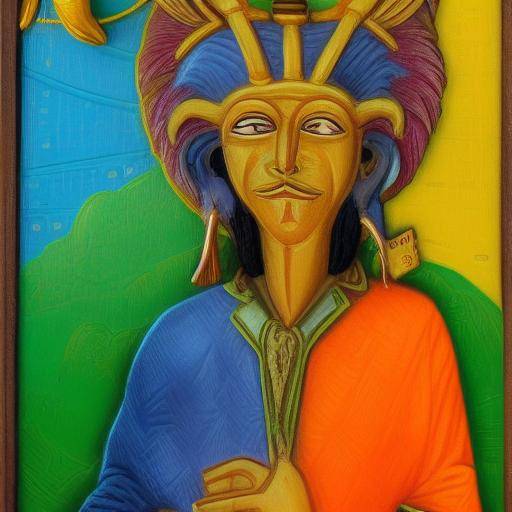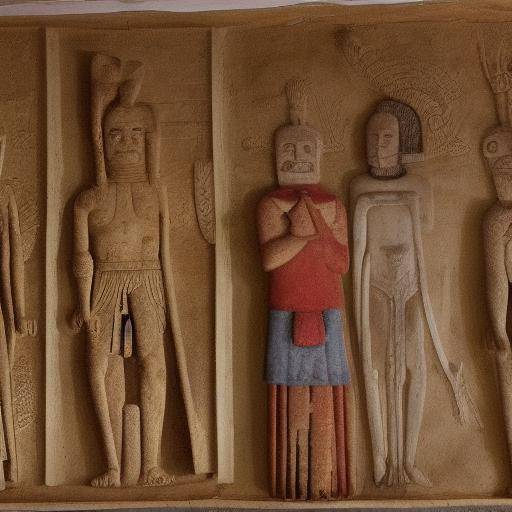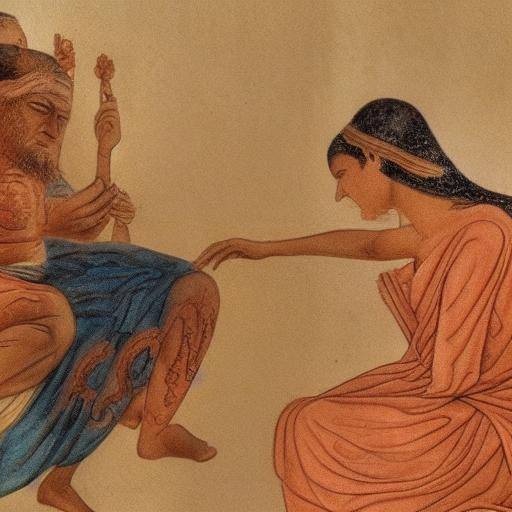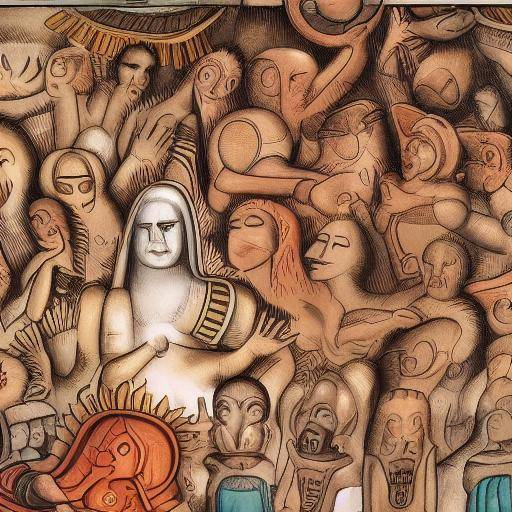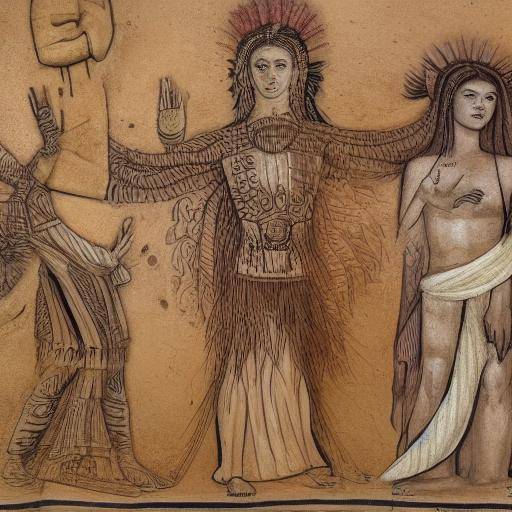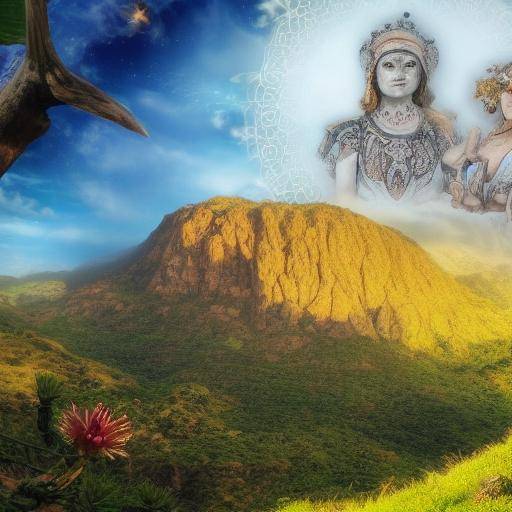
Introduction
Egyptian mythology is a fascinating universe in which Pharaohs were more than simple rulers; they were considered divinities on Earth. This article will take you to a journey through time to discover the stories of divinized Pharaohs, exploring their impact on Egyptian mythology and the concept of divinity. From the origin of this belief to its influence on society and religion, immerse yourself in an enriching account that reveals the complexities of ancient Egyptian culture and its lasting legacy.
History and Background
Ancient Egypt witnessed a splendour and complex system of beliefs around the figure of Pharaoh as a divine being. From the beginning of the Pharaonic reign, the top leader of ancient Egypt was considered a direct link with the gods and, in many cases, a living deity. We will explore how this conception was rooted in the lineage of the Pharaohs, their ritual research and religious practices that confirmed their divinity.
Origins of the Divinity Pharaohica
The idea of Pharaonic divinity goes back to the first Egyptian dynasties. The Pharaohs were seen as incarnations of Horus, the falcon god of heaven, and when they died they became Osiris, the god of the dead and the resurrection. This cycle of death and resurrection symbolized the perpetuality of the Pharaonic power and its unbreakable connection with the gods.
Research and Ritual
The coronation of a pharaoh was not only a political act but also a religious ritual. During the coronation ceremony, Pharaoh was invested with the symbols of divine power, such as the double crown representing the unification of Upper and Lower Egypt. In addition, rituals were performed to ensure that Pharaoh was accepted as a living god by the deities of the Egyptian pantheon.
Analysis in Deep
The implications of having a Pharaoh as an earthly divinity were vast and complex. We will explore how this conceptualization of the divine influenced issues as diverse as the construction of monuments, funeral practices and art, as well as its role in the complex system of beliefs related to the beyond, the resurrection and the final judgment.
Monuments and Temples
The Pharaohs built imposing monuments and temples to affirm their divinity and leave an eternal legacy. Pyramids, like Giza's, are examples of how the Pharaohs sought to immortalize their power and secure their place in eternity. These monuments not only served as graves but also as places of worship where the devinized pharaoh was honored.
Funeral practices
Funeral practices in ancient Egypt were deeply influenced by the belief in Pharaonic divinity. The Pharaohs were embalmed and buried with great wealth, accompanied by funeral texts such as the "Book of the Dead" that guided their soul in the beyond. The preservation of the body and soul of Pharaoh was crucial to ensuring his resurrection and eternal reign in the world of the gods.
Comprehensive review
The impact of the Pharaonic divinity transcended the religious and socio-political spheres. We will explore its influence in building a national identity, the development of religious institutions and the social class system. We will also evaluate the legacy left in the literature, philosophy and study of Egyptian history, revealing the lasting dimension of these beliefs.
National identity and social cohesion
Pharaoh's divinity helped build a strong and cohesive national identity. The Pharaohs were symbols of unity and stability, and their divinity served to legitimize their authority and maintain social order. This conception helped to strengthen social cohesion and promote allegiance to Pharaoh and the Egyptian state.
Development of Religious Institutions
Religious institutions in Egypt were closely linked to Pharaonic worship. The temples were not only centers of worship but also administrative and economic centres. The clergy, which served in these temples, played a crucial role in the spread of the Pharaonic divinity and in the realization of rituals that ensured the prosperity and divine protection for Egypt.
Comparative analysis
In order to understand the complete picture, we will perform a comparative analysis between the stories of divinized Pharaohs, Egyptian mythology and the concept of divinity in other contemporary civilizations. This will allow us to identify similarities, differences and points of convergence that will shed light on the universality of the divinization of political leaders in historical contexts.
Comparison with Other Civilizations
In many ancient civilizations, political leaders were seen as divine or semi-divine figures. We will compare the Pharaonic divinity with the worship of the emperors in Rome, the concept of king-sacerdote in Mesopotamia and the living divinities in the pre-Columbian cultures. This analysis will allow us to understand how different cultures have used the divinization of their leaders to strengthen political and social power.
Practical Tips and Accessible Tips
Within the framework of this complex theme, we will provide practical and actionable advice to understand and appreciate the pharaonic divinity, as well as its relation to Egyptian mythology and the concept of divinity. These advices will serve as a guide to contextualize and appreciate the influence of these concepts in ancient society and their current relevance in the study of history and mythology.
Student and Research Tips
- Study Primary Sources: Explore ancient texts such as the "Book of the Dead" and the inscriptions of the temples to obtain a direct understanding of the beliefs and practices related to the Pharaonic divinity.
- Visit Museums and Archaeological Sites: The displays of Egyptian artifacts and visits to archaeological sites such as the pyramids of Giza and the Valley of the Kings offer a tangible experience of the magnificence of Egyptian civilization.
- Participate in Seminars and Conferences: Join academic events where the latest findings and theories about religion and politics are discussed in ancient Egypt.
Industry Perspectives and Expert Reviews
We will gather perspectives of experts in history, archaeology, egyptology and mythology to present an integral vision of Pharaonic divinity and its impact on Egyptian mythology. We will explore the contemporary implications of these beliefs in academic study, as well as their relevance in the understanding of ancient religions and cosmogonies.
Opinions of Experts
- Dr. Zahi Hawass, Egyptian archaeologist, highlights the importance of recent discoveries that shed light on the coronation rituals and the perception of Pharaonic divinity.
- Dr. Salima IkramEgyptian, explains how funeral practices and religious texts reflect the complex relationship between the Pharaohs and the gods.
Case Studies and Applications in Real Life
We will illustrate the concepts discussed through specific cases that show how Pharaonic divinity permeated key aspects of life in ancient Egypt. These case studies will show the practical manifestation of the alleged divinity of the Pharaoh in significant events, monumental constructions, and ritual practices throughout Egyptian history.
Case Study: Ramses II
Ramses II, known as Ramses the Great, is an outstanding example of a divinized pharaoh. During his reign, numerous temples and monuments were built that represented him as a living god. We will analyze how these constructions not only reinforced their power, but also perpetuated their divine legacy throughout the centuries.
Future Trends and Predictions
Finally, we will project towards the future to identify emerging trends in the study of Egyptian mythology, divinity and the role of Pharaoh. Based on historical learning, academic advances and areas of research in development, we will anticipate possible directions that will guide the understanding of these topics in the coming decades.
Future Research Directions
- Technology and Archaeology: The use of advanced technologies such as computed tomography and artificial intelligence to analyze mummies and artifacts could reveal new data on religious practices and the perception of Pharaonic divinity.
- Interdisciplinary: Collaboration between disciplines such as anthropology, the history of art and theology can offer more integrated and complex perspectives on the figure of the divinized pharaoh.
Conclusions and FAQs
Conclusion
In this section, we will summarize and reinforce the key points discussed throughout the article. We will consolidate the importance of understanding the stories of divinized Pharaohs, Egyptian mythology and
the concept of divinity in the cultural and religious context of ancient Egyptian civilization. We will also urge readers to continue exploring this fascinating theme.
Frequently asked questions
- How was Pharaoh supposed to be divine in Egyptian mythology?
- The Pharaohs were seen as the incarnations of Horus in life and Osiris in death, symbolizing their direct connection with the gods.
- What was the role of the pharaohs divinized in the daily life of ancient Egypt?
- The devinized Pharaohs were mediators between the gods and the people, responsible for maintaining harmony and prosperity.
- What was the relationship between the divinity of Pharaoh and the Egyptian gods?
- The Pharaohs were considered sons of the gods and their representation on Earth, playing both divine and political roles.
- What archaeological evidence supports the belief in the divinity of the Pharaohs?
- Monuments, inscriptions and religious texts that represent Pharaohs as living gods and their role in religious rituals.
- How did the perception of Pharaonic divinity evolve throughout Egyptian history?
- The perception of Pharaonic divinity varied with each dynasty, adapting to political and social changes, but always maintaining the core of its divinity.
- What is the contemporary relevance of understanding the divinity of the Pharaohs in the study of mythology and Egyptian history?
- It helps to understand the social, political and religious structure of ancient Egypt and its influence on Western civilization.
With this, we concluded our journey through the stories of divinized Pharaohs, Egyptian mythology and the concept of divinity in ancient Egypt. We hope that this exploration has been enriching and that it has awakened your interest to know more about this fascinating culture and its lasting legacy in the history of humanity.


